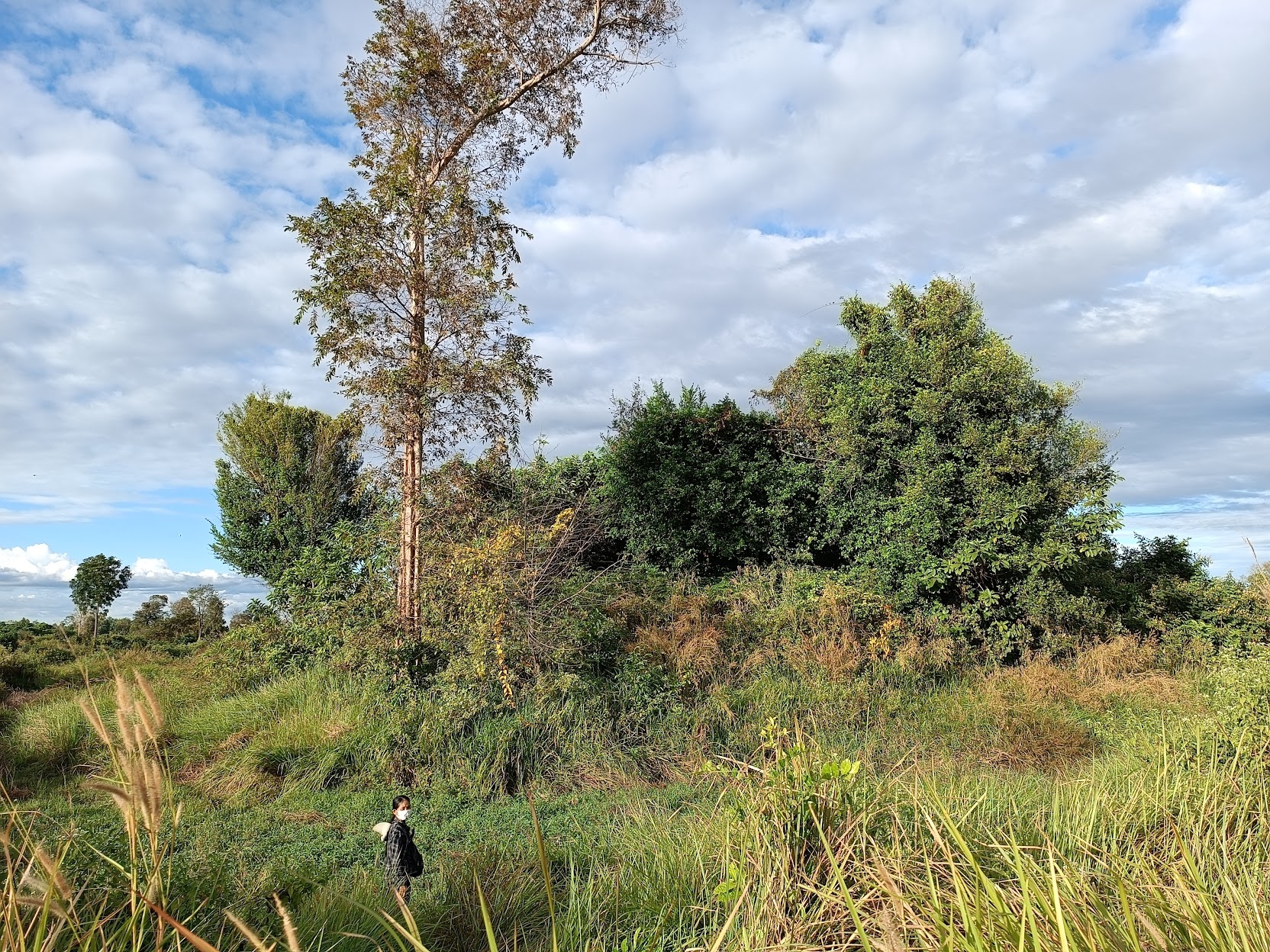- Area: Siem Reap Province > Svay Leu District > Kantuot Commune > Dambok Khpuos Village
- | Type: Ancient Remains & Temples
Located north of Kulen Mountain in the commune of Kantout, the moated 10th-century temple site features the remains of three temples, “library” building, enclosed by a laterite wall with eastern gopura. Three inscriptions were registered from the site.
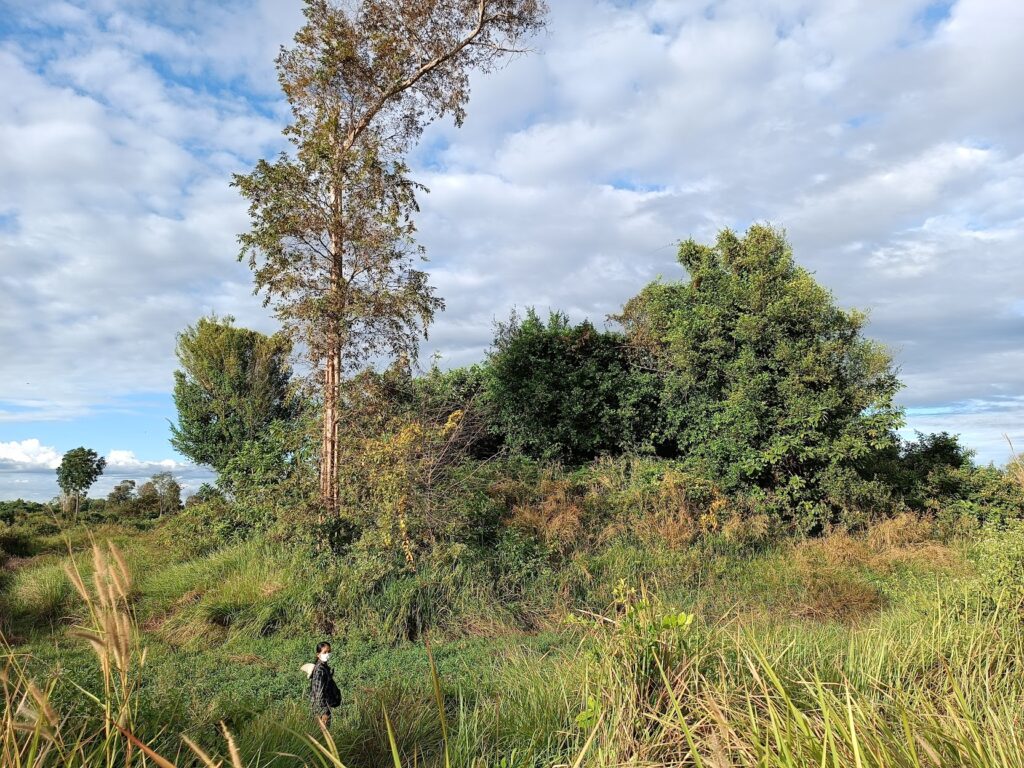
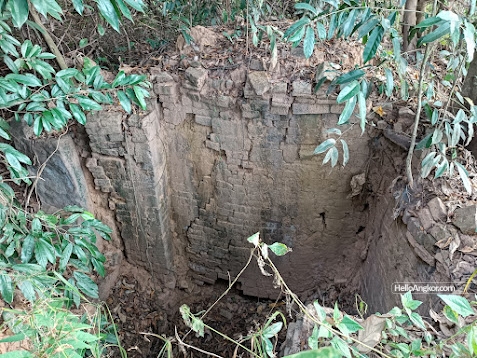
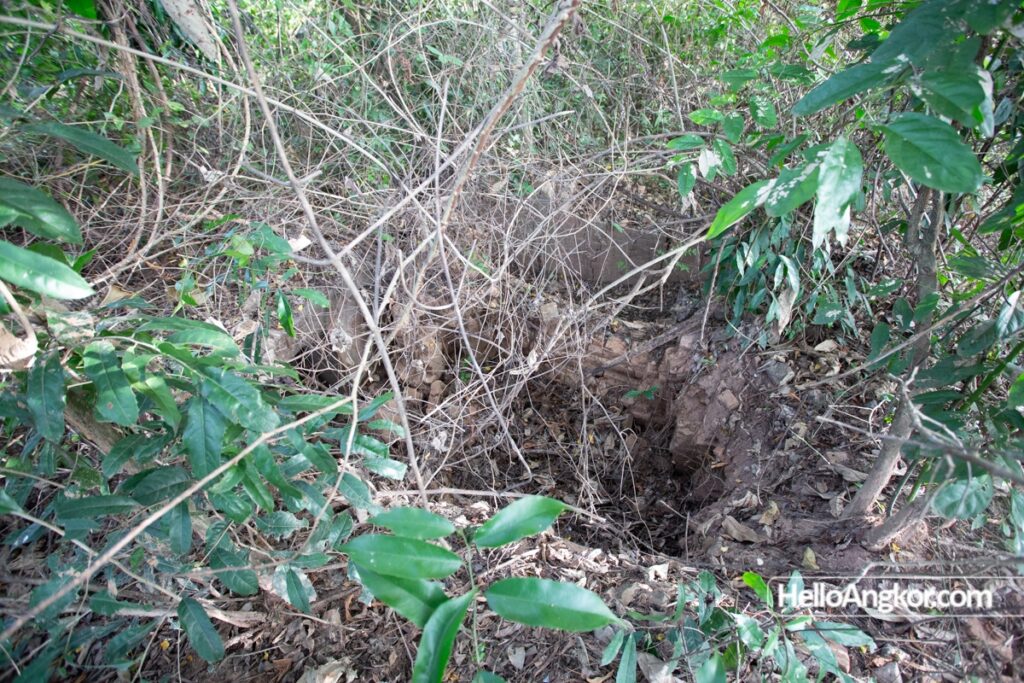
The site is reasonably easy to reach (12/22) with a farm trail leading off the dirt road that connects Svay Leu to Khnar. The site is heavily overgrown and we decided not to explore any further beyond the shots you see until authorities clear the site.
The earliest review of the site is by Boulbert and Dagens, published in 1973
This temple located west of “Aur Dham” to which it is connected by a causeway-dike, it is bordered to the south-west by a complex set of dikes and landscaped ponds. It owes its current name to an image of Vrsabha (Photo 35), a reputed and efficient genius whose spirit is periodically revealed through the intermediary of a medium. This statue which recently stood in the courtyard of the temple was taken to safety in the surrounding forest by the faithful who led us to its current location.
H. Parmentier visited this monument in 1932. He left no description of it to our knowledge, but the inscriptions he had recorded on the jambs of the three sanctuary towers were published by G. Codes. They commemorate various foundations ranging from 979 to 1013; the oldest of these foundations seem to be able to be attributed to the famous Shivacarya, high priest of Jayavarman V and corresponds to the foundation of the temple itself, which everything suggests dates from the beginning of the third quarter of the tenth century.
Small in size and close together, the three brick sanctuary towers are ruined at the height of the top of their doors, they are buried under their own rubble and only their east face appears, no doubt cleared by H. Parmentier to find and record the inscriptions on each of their side walls.
The vast courtyard to the east of the towers is only occupied by a library located in the southeast corner, of which only a heap of rubble remains. The very ruined laterite enclosure seems to have broken only the vast entrance pavilion (Photo 36) which occupies almost the entire east face. This building with three passages is built in sandstone, laterite and bricks (vaults); the small entrance is preceded by a forebody to the east and to the west.
Only the lintel of the western forebody is visible (Photo 37 & 38): it represents the churning of the sea of milk, appearing on two registers. In the lower register, there is nothing to distinguish the Asura from the Deva among the figures holding the body of Vasuki, whose head is on the right of the composition. In the center Mount Mandara is figured in the form of a pillar whose base is Visnu-Kurma and whose capital serves as the throne of Vishnu Caturbhuja (upper register); a two-armed god, Krishna or Indra, hangs on halfway up the ribot and encourages Deva and Asura. To the left of the ribot and above the head of the tortuse is the head of Sri, to the right is the horse Uccaihsravas and, spreading upwards, the tree Parijata. In the center of the upper register, Vishnu Caturbhuja adorned and equipped with his usual attributes sits between Candra (sitting on a molded base) and Surya (on a pole): this last god extends an arm towards the left and thus seems to denounce the presence of Rahu, like the narrative of the Mahabharata Adiparra. To Surya’s right are Brahma and two indistinct featureless worshipers. To the left of Candra a man wearing a bun is standing behind a quadruped. We can see Shiva (or Risi) accompanying Vrsabha, although the animal looks as much like a horse as a bull… Further on a god wearing a bun, probably Shiva Nilakantha, faces a woman: the flask (of amrita) placed at her feet makes her recognize as Mohini, the feminine form taken by Vishnu to recover the amrita. Finally, at the left end we see a diademed worshiper praying and Rahu figured in his traditional form but still holding the bottle of amrita he had stolen.
In the courtyard of the temple are three pieces of sculpture (Photo 39): the first is a stele probably intended to receive an inscription that has not been engraved, at the bottom of the front face is single, in high relief, the image of Ganesha the eight-armed god is seated under an areature. The second of these sculptures (Photo 40; 1m height) is the image in the round of a male figure with two arms on a square base, the left leg folded under the body, the head, the arms and the right leg has disappeared, the short, pleated garment is held by a smooth belt that is hidden in front by a wide flap, and behind, the tail clothing wraps around and spreads out like a fan above; this image is similar to those well known from Banteay Srei.
Finally, a linga lay in the yard; height 15 cm approx. (Photo 41): it has the particularity of comprising only two sections, the rounded rudrabhaga with a well-marked fillet and the octagonal vishnubhaga which entirely occupies the place it generally shares with the brahmabhaga: one can wonder whether there is no correspondence between this linga and the inscription on the north jamb of the south tower where the unity of Hari and Sankara is mentioned.

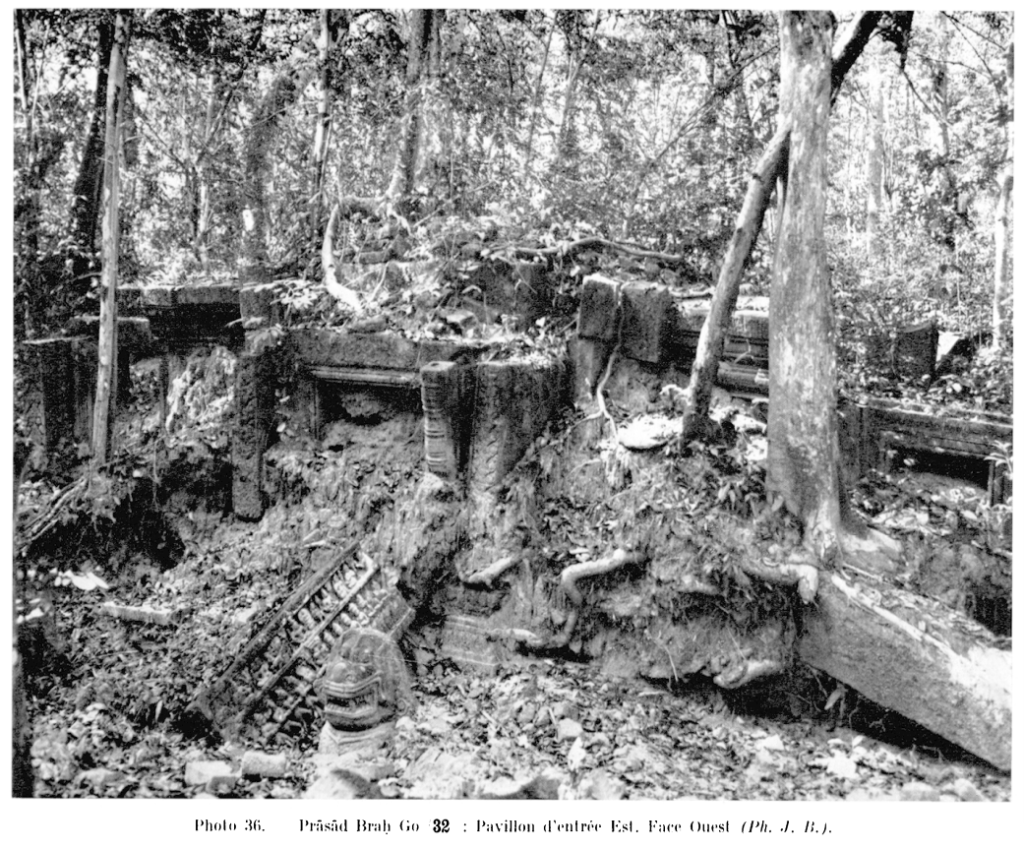
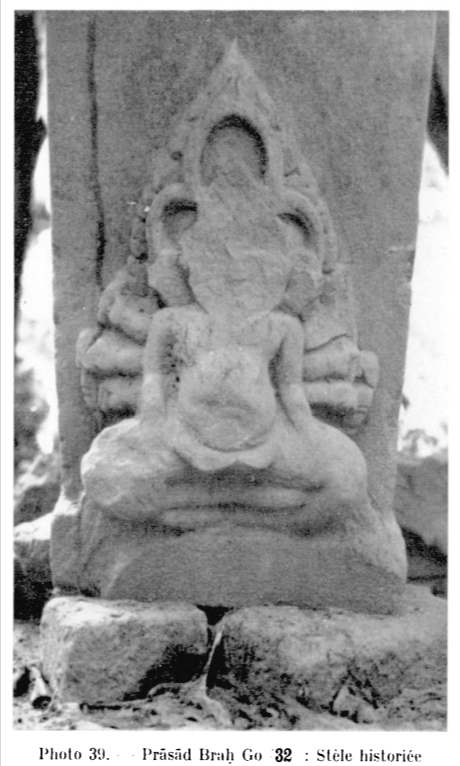
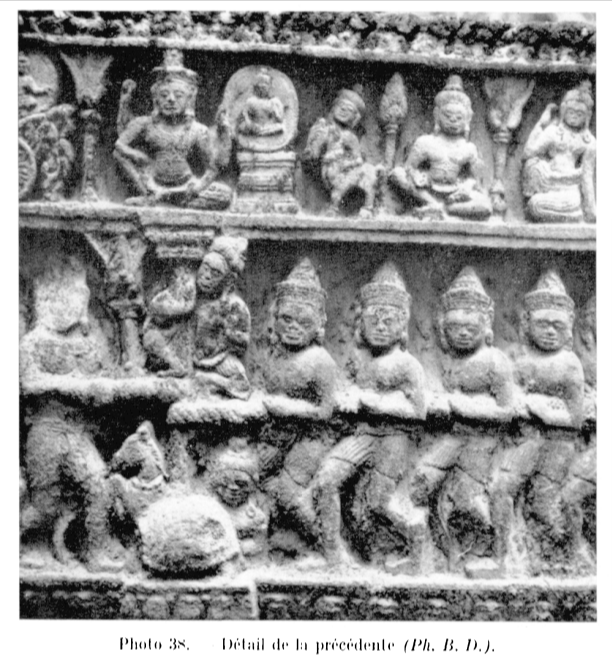
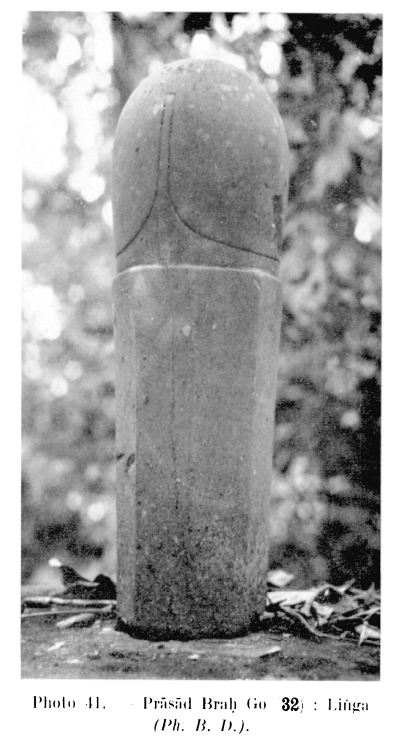

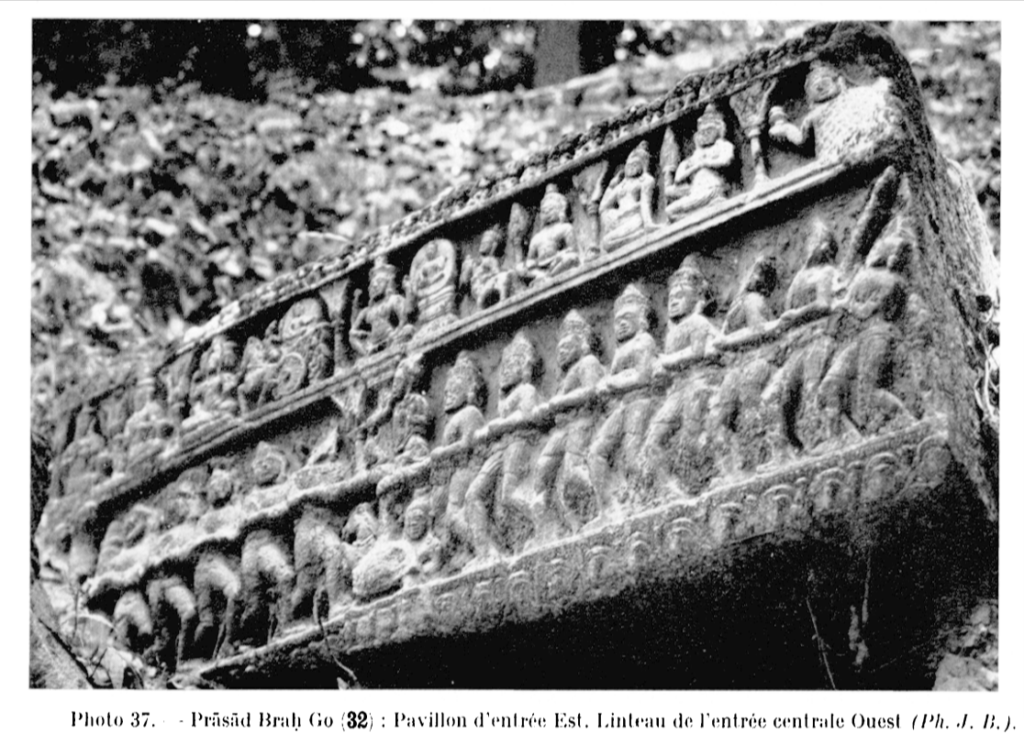
Inscriptions
- K. 706 – 30 + 16 lines of Sanskrit and 18 lines of Khmer – IC V, p. 217
- K. 707 – 24 + 22 lines of Sanskrit – IC V, p. 220
- K. 708 – 10 + 20 lines of Khmer text – IC V, p. 221
References
- Les Sites Archeologiques de la region Bhnam Gulen, Boulbert and Dagens 1973
Map
Site Info
- Site Name: Preah Kô (Pr.) Khmer Name: បា្រសាទព្រះគោ
- Reference ID: HA15352 | Posted: January 19, 2021 | Last Update: December 24th, 2022
- Other Names: Prasad Brah Go
- Tags/Group: 10th Century, b, Kulen, pr, Temples
- Location: Siem Reap Province > Svay Leu District > Kantuot Commune > Dambok Khpuos Village
- MoCFA ID: 5708
- IK Number: 250.02
- Inscription Number/s: K. 706, 707, 708

